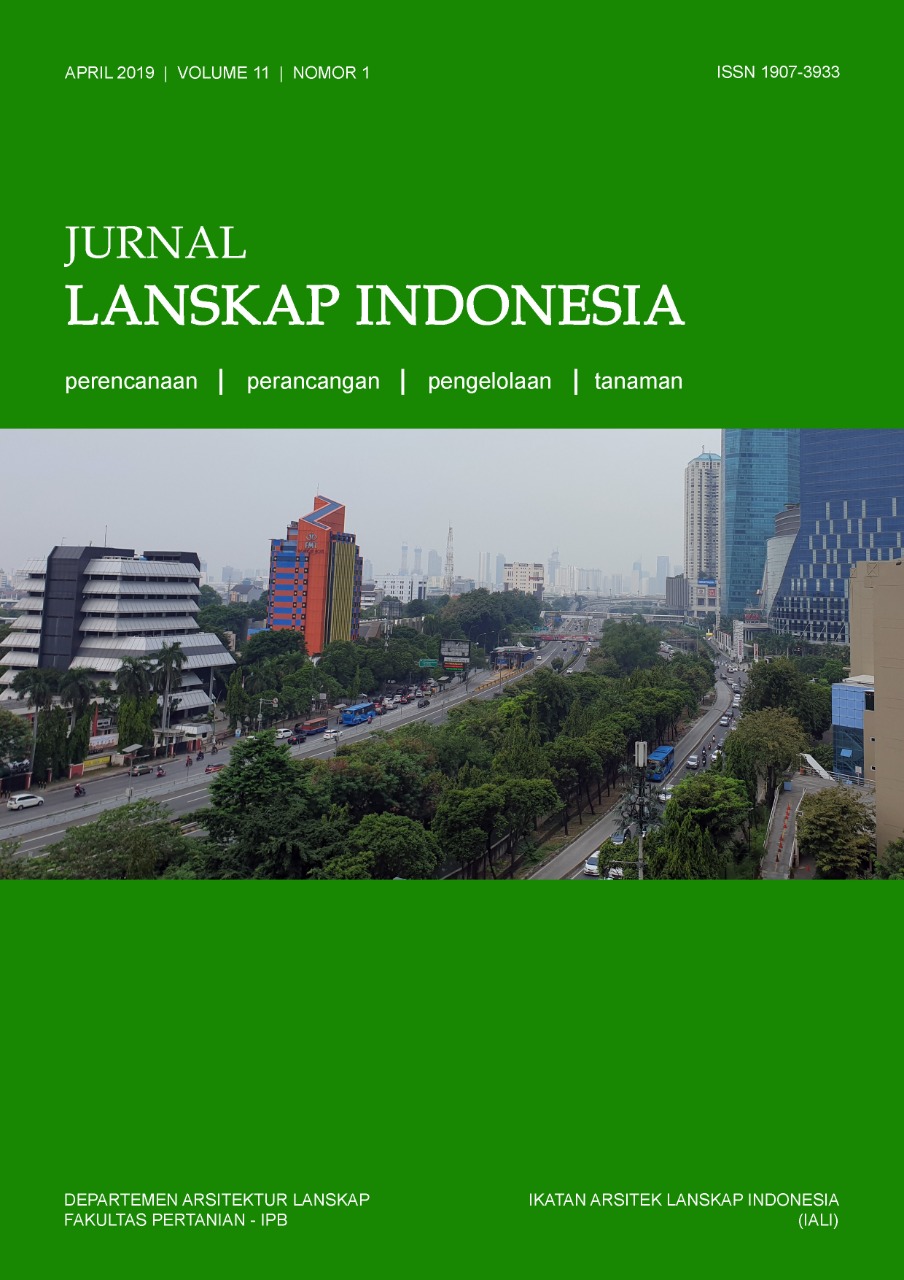Persepsi dan Preferensi Masyarakat terhadap Infrastruktur Hijau Kota Yogyakarta
Abstract
Green infrastructure has been indicated as promising measure for adaptation to climate change impact, especially in densely populated cities where green spaces in a big scale were rare. Yogyakarta City expected would be a good representative case study, due the urban density and limited green spaces. In order to gain a better understanding and awareness of climate change impact and green infrastructure benefit, it is important to find out how people think about issues related to it. Perceptual studies can generate more understanding of the research areas, and knowing the preferences for implementing green infrastructure can help urban planners identify more effective policy responses. The objective of this study is to analyze public perceptions and preferences on climate change and green infrastructure in Yogyakarta City. The study area located in Yogyakarta City is divided into three groups based on the difference proportion of surface temperature. Data collecting conducted by online questionnaires, and samples selection used accidental sampling method. Descriptive statistics used to analyze descriptive data, chi square and Kruskal-Wallis analysis were used to determine the differences between three study areas, then logistic regression method used to find out the influence of socio-demographic factors. The results showed that there were not many significant differences between the 3 groups of study areas on community perceptions and preferences, while socio-demographic factors such as age, occupation, and gender affect some results of community perceptions and preferences. This study explains how community’s awareness of climate change impacts and understanding of the benefits of green infrastructure and local preferences, so that the benefits of green infrastructure can be accepted by the community effectively.
Downloads
References
Asgarzadeh M, Lusk A, Koga T, Hirate K. 2012. Measuring oppressiveness of streetscapes. Landsc. Urban Plan. 107 (1), 1–11.
Bjerke T, Østdahl T, Thrane C, & Strumse E. 2006. Vegetation density of urban parks and perceived appropriateness for recreation. Urban Forestry & Urban Greening, 5, 35–44.
Brown R, Vanos JK, Kenny NA, Lenzholzer S. 2015. Designing urban parks that ameliorate the effects of climate change. Landscape and Urban Planning, 138, 118–131.
Byrne J & Yang J. 2009. Can urban greenspace combat climate change? Towards a subtropical cities research agenda. Australian Planner, 46, 36–43.
Chan KMA, Satterfield T, Goldstein J. 2012. Rethinking ecosystem services to better address and navigate cultural values. Ecol. Econ. 74, 8–18.
Demuzere M, Orru K, Heidrich O, Olazabal E, Geneletti D, Orru H. 2014. Mitigating and adapting to climate change: multi-functional and multi-scale assessment of green urban infrastructure. Journal of Environmental Management, 146, 107–115.
Derkzen ML, Teeffelen AJ, Verburg PH. 2017. Green infrastructure for urban climate adaptation: How do residents’ views on climate impacts and green infrastructure shape adaptation preferences? Landscape and Urban Planning, 157, 106–130.
Gao J, Sun Y, Liu Q, Zhou M, Lu Y, & Li L. 2015. Impact of extreme high temperature on mortality and regional level definition of heat wave: a multi-city study in China. Science of the Total Environment, 505, 535–544.
Guntara I. 2015. Pemanfaatan Citra Landsat 8 untuk Mengestimasi Suhu Permukaan Lahan (Land Surface Temperature) di Kabupaten Bantul Menggunakan Split Window Algorithm [skripsi]. Yogyakarta (ID): Universitas Gajah Mada.
Jim CY & Chen W. 2006. Perception and attitude of residents toward urban green spaces in guangzhou (China). Environmental Management, 38, 338–349.
Karina, Kusuma H E, Primasari L. 2017. Kriteria Ruang Terbuka menurut Persepsi Masyarakat di Kota Palembang. Prosiding Temu Ilmiah IPLBI.
Kurz T & Baudains C. 2010. Biodiversity in the front yard: An investigation of landscape preference in a domestic urban context. Environment and Behavior, 44, 166–196.
Mell IC. 2010. Green Infrastructure: Concepts, Perceptions and Its Use in Spatial Planning. University of Newcastle, Newcastle (Ph.D. thesis).
Mansor M, Said I, Mohamad I. 2012. Experiential contacts with green infrastructure's diversity and well-being of urban community. Procedia Social Behavior. Sci. 49, 257-267.
Madureira H, & Andresen T. 2014. Planning for multifunctional urban green infrastructures: Promises and challenges. Urban Design International, 19, 38–49.
Nurisjah. 2005. Penilaian Masyarakat Terhadap Ruang Terbuka Hijau (RTH) Wilayah Perkotaan: Kasus Kotamadya Bogor [disertasi]. Bogor (ID): Institut Pertanian Bogor.
Schroeder HW, Flannigan J, Coles R. 2006. Residents attitudes toward street trees in the UK and U.S. communities. Arboricult. Urban For. 32 (5), 236–246.
Semenza JC, Hall DE, Wilson DJ, Bontempo BD, Sailor DJ, George LA. 2008. Public Perception of Climate Change Voluntary Mitigation and Barriers to Behavior Change. American Journal of Preventive Medicine. 35(5), 479-487.
Tzoulas K, Korpela K, Venn S, Yli-Pelkonen V, Kazmierczak A, Niemela J, James P. 2007. Promoting ecosystem and human health in urban areas using Green Infrastructure: A literature review. Landscape and Urban Planning, 81, 167–178.
Wang R, Zhao J. 2017. Demographic groups differences in visual preference for vegetated landscapes in urban green space. Sustainable Cities and Society. 28 350–357.
Yusliana. 2013. Mewujudkan yogyakarta sebagai kota hijau berwawasan lingkungan. Rekayasa Teknologi Industri dan Informasi. 66-68.
This journal permits and encourages authors to post items submitted to the journal on personal websites or institutional repositories both prior to and after publication, while providing bibliographic details that credit, if applicable, its publication in this journal. However, after the article is submitted and published in this journal, it is fully copyrighted by the Jurnal Lanskap Indonesia or JLI. If excerpts from other copyrighted works are included, the author must obtain written permission from the copyright owner and give credit to the source in the article. Then, the writer or reader is allowed to copy, share, and redistribute articles/material in any form. But it must still include the appropriate source and credit because the article in this journal is licensed by Creative Commons Attribution 4.0 International License (CC BY 4.0).
I. Proposed Policy for Journals That Offer Open Access
Authors who publish with this journal agree to the following terms:
- Authors retain copyright and grant the journal right of first publication with the work simultaneously licensed under a Creative Commons Attribution License that allows others to share the work with an acknowledgement of the work's authorship and initial publication in this journal.
- Authors are able to enter into separate, additional contractual arrangements for the non-exclusive distribution of the journal's published version of the work (e.g., post it to an institutional repository or publish it in a book), with an acknowledgement of its initial publication in this journal.
- Authors are permitted and encouraged to post their work online (e.g., in institutional repositories or on their website) prior to and during the submission process, as it can lead to productive exchanges, as well as earlier and greater citation of published work (See The Effect of Open Access).
II. Proposed Policy for Journals That Offer Delayed Open Access
Authors who publish with this journal agree to the following terms:
- Authors retain copyright and grant the journal right of first publication, with the work after publication simultaneously licensed under a Creative Commons Attribution License that allows others to share the work with an acknowledgement of the work's authorship and initial publication in this journal.
- Authors are able to enter into separate, additional contractual arrangements for the non-exclusive distribution of the journal's published version of the work (e.g., post it to an institutional repository or publish it in a book), with an acknowledgement of its initial publication in this journal.
- Authors are permitted and encouraged to post their work online (e.g., in institutional repositories or on their website) prior to and during the submission process, as it can lead to productive exchanges, as well as earlier and greater citation of published work (See The Effect of Open Access).



























